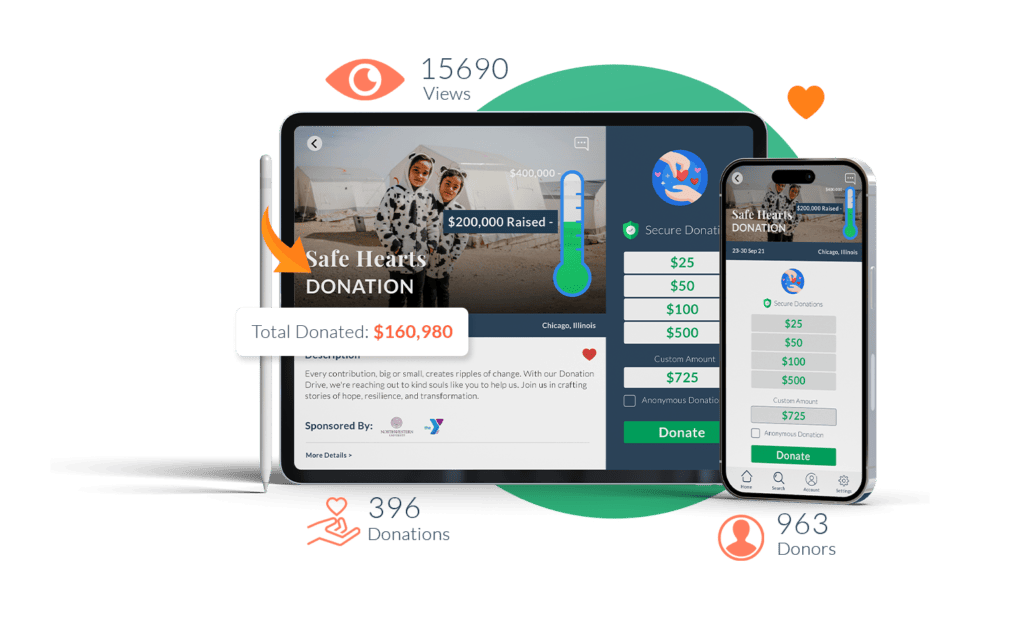
You’ve been volunteering in your community for a long time, and you’re ready to take the next steps towards solving a particular problem. Or, perhaps you’ve identified a way to help people, animals, or your environment, but you know that a team of one can’t make the difference that an organization can. How do you start a nonprofit so that you can tackle the issues you care about without spending all your own time and money on it?
Starting a nonprofit organization can be a fulfilling and impactful way to make a difference in your community. However, it can also be a daunting and complex process. In this guide, we will walk you through the steps of starting a successful nonprofit, from defining your mission to obtaining tax-exempt status.
Why Start a Nonprofit?
A nonprofit is a tax-exempt organization that works towards some type of social cause. This cause could be humanitarian, religious, political, etc., but the key is that the organization does not make a profit for itself. It makes enough money to sustain its efforts, the rest goes towards its goal of solving social needs or issues.
There are many types of causes out there, and many types of nonprofits to serve them, but here are just a few reasons why you might want to start one yourself.
Fulfill a Need in Your Community
One of the main reasons people start nonprofits is to address a need or issue in their community. Whether it’s providing resources for the homeless, promoting education, or supporting a specific cause, starting a nonprofit allows you to make a direct impact on the lives of others.
For example, The Little Red Dog was created to combat dog-fighting and to provide refuge for abused dogs. You can learn all about their mission in our podcast with founder PJ.
Tax Benefits
Nonprofits are tax-exempt organizations, meaning they do not have to pay federal or state income taxes. This can save your organization a significant amount of money and allow you to allocate more resources towards your mission.
Not only does achieving 501(c) status provide you with tax advantages, it will make you eligible for grants provided by foundations and make you more attractive to potential sponsors. People with money and other services to donate will see your 501(c) status as a mark of trustworthiness.
Personal Fulfillment
Starting a nonprofit can also be personally fulfilling. It allows you to use your skills and passions to make a positive impact and create meaningful change in the world. If you’ve grown tired of or disillusioned with your career in the corporate world and you can see a real path forward for your nonprofit, it might be time to consider dedicating yourself to something more
Define Your Mission and Vision
Before starting a nonprofit, it’s important to have a clear understanding of your mission and vision. Your mission statement should clearly define the purpose of your organization and the impact you hope to make. Your vision statement should outline your long-term goals and aspirations for the organization.
Your mission and vision statements will serve as the foundation for your nonprofit and guide all of your decisions and actions.
Tips for writing an effective auction mission statement
- Know Your Audience Before you start writing your mission statement, it’s important to understand your audience. Who are you trying to attract to your auction? What values and beliefs do they hold?
- Keep It Concise A mission statement should be short and to the point. Aim for a maximum of two sentences that clearly and succinctly communicate who you are and your auction’s purpose.
- Use Clear and Simple Language Avoid using jargon or complex language in your mission statement. Use simple and straightforward language that is easy for anyone to understand. This will ensure that your mission statement is accessible to a wide audience and effectively communicates your message.
- Be Specific Your mission statement should be specific to your organization and its goals. Avoid using generic or vague statements that could apply to any auction. Instead, focus on what makes your auction unique and what you hope to achieve through it.
- Make It Memorable A memorable mission statement is one that sticks in people’s minds and resonates with them. If you can, appeal to your audience’s emotions, or perhaps their sense of humor.
- Get Feedback Before finalizing your mission statement, it’s important to get feedback from others. Share your draft with members of your organization. This will help you refine your mission statement and ensure that it effectively communicates your organization’s values and goals.
Conduct Market Research
Before officially starting your nonprofit, it’s important to conduct market research to ensure there is a need for your organization in your community. This will also help you identify potential competitors and determine how your nonprofit can differentiate itself. It might seem strange to think of an organization that doesn’t make a profit having competitors, but you will need to know who else is operating in your niche and how well they serve the needs of the community.
Market research can also help you identify potential donors and volunteers, as well as understand the demographics and needs of your target audience.
Have clear answers to the following questions:
- Who will my organization serve? This should be answered by your mission statement: who or what are you trying to help, and how do you plan to help them?
- Are there organizations that already serve this need nearby? If there are organizations that serve this purpose already, what do you like or dislike about how they operate? Is the need simply so great that you feel more needs to be done? These organizations might not appreciate it if you create another nonprofit with a similar mission: after all, there are only so many donors you can both reach. You’ll need to be ready to explain why your nonprofit is different from the competition.
- How does your community feel about the need and/or the organizations that might already be trying to serve it? Some causes can be a source of contention: they might be politically controversial or people might simply feel they aren’t worth the money. You should conduct some surveys, even informal ones, to get a feel for any pushback your organizations might face.
Create a Business Plan
Just like any other business, a nonprofit needs a solid business plan to be successful. This plan should outline your goals, strategies, and financial projections for the organization. Your business plan should also include a detailed budget, as well as a plan for fundraising and sustainability.
Choose a Legal Structure and Name
There are several legal structures to choose from when starting a nonprofit, including a charitable trust, association, or corporation. Each structure has its own benefits and requirements, so it’s important to research and choose the one that best fits your organization’s needs.
Explore our article on different types of nonprofit organizations and what purposes they serve
You will also need to choose a name for your nonprofit and ensure it is not already in use by another organization. Make sure to Google your nonprofit name ideas to ensure that they or their acronyms don’t resemble any unfortunate slang or accidentally translate to something terrible in another language. Most of all, keep your nonprofit name short and memorable: it’s difficult to give an elevator pitch when your name is several words long.
Register Your Nonprofit
Once you have chosen a legal structure and name for your nonprofit, you will need to register it with the appropriate state and federal agencies. This typically involves filing articles of incorporation and obtaining a tax identification number. You may also need to register for state and local tax exemptions, depending on your location.
This is different from applying for tax exempt status, which is further down our list.

by Dayne Topkin, Unsplash
Develop a Board of Directors
A board of directors is a group of individuals who oversee the operations and decision-making of a nonprofit organization. It’s important to choose board members who are passionate about your cause and have the skills and experience to help your organization succeed. Not every nonprofit will necessarily require this level of organization, but if you are a mission-driven nonprofit you will need board members who can help you further your cause.
Your board of directors should be diverse and representative of your community. Having a variety of opinions and perspectives on your board is valuable to decision-making, and can help ensure that your organization will pursue its goals with sensitivity and fairness.
Create a Fundraising Plan
Fundraising is a crucial aspect of running a successful nonprofit. Your fundraising plan should outline your strategies for obtaining donations and grants, as well as any events or campaigns you plan to hold. It’s important to diversify your fundraising efforts and not rely on one source for all of your funding.
Tips on Creating a Nonprofit Fundraising Strategy:
- Set Clear Goals: Know your budget for operations, fundraising, and extra expenses.
- Know Your Audience: Research potential donors as well as potential naysayers.
- Utilize Technology: There are a variety of tools designed to help nonprofits with everyday tasks as well as fundraising (like our platform): put them to work for you.
- Create a Compelling Story: You’ll need to be ready to explain why your organization exists right off the bat. Tell the story of the people, pets, or places you’re trying to help.
Apply for Tax-Exempt Status
To be recognized as a tax-exempt organization, you will need to apply for 501(c)(3) status with the IRS. This involves filling out an application and providing detailed information about your organization’s mission, activities, and finances.
Obtaining tax-exempt status can take several months, so it’s important to start this process early. Here’s where you can start to apply for 501(c)(3) status with the IRS.
Establish Policies and Procedures
To ensure your nonprofit runs smoothly and ethically, it’s important to establish policies and procedures for your organization. This can include guidelines for financial management, conflict of interest, and board member responsibilities. Having clear policies and procedures in place can also help with transparency and accountability.
Promote Your Nonprofit
Once your nonprofit is up and running, it’s important to promote it to raise awareness and attract donors and volunteers. This can include creating a website, email marketing, using social media, and networking with other organizations and individuals in your community.
It’s also important to regularly communicate with your donors and volunteers to keep them updated on your organization’s progress and impact. Make sure you have a consistent communication strategy and schedule in place for both regular messages and event-specific promotions.
Takeaways
Starting a nonprofit can be a challenging but rewarding experience. By following these steps and staying dedicated to your mission, you can create a successful nonprofit that makes a positive impact in your community. Remember to continuously evaluate and adapt your strategies to ensure your organization’s continued success.






